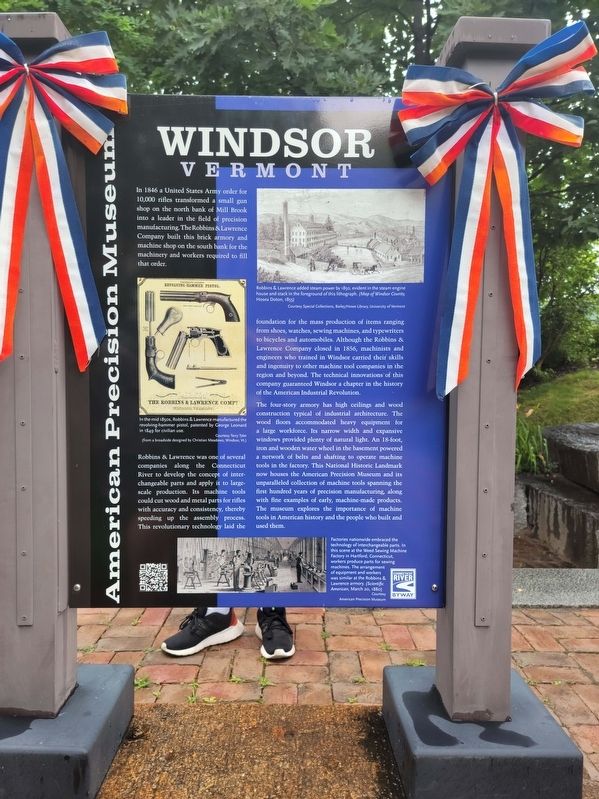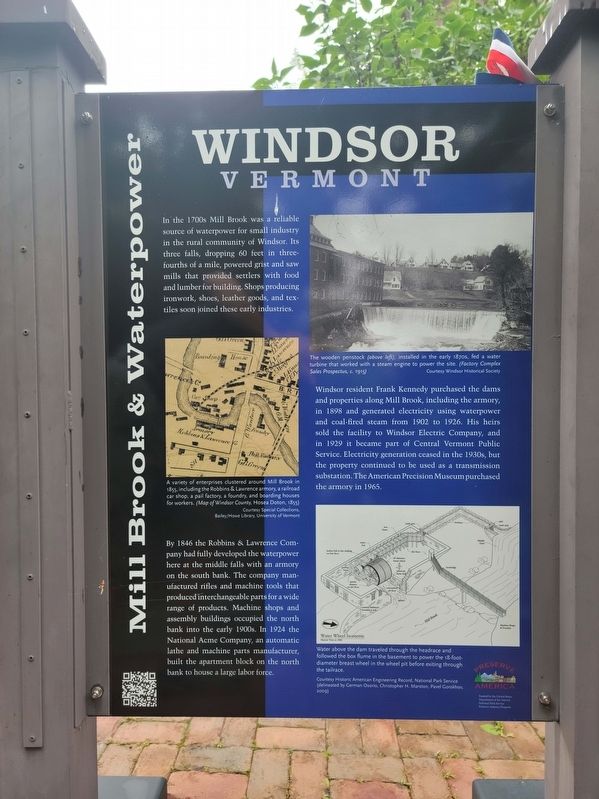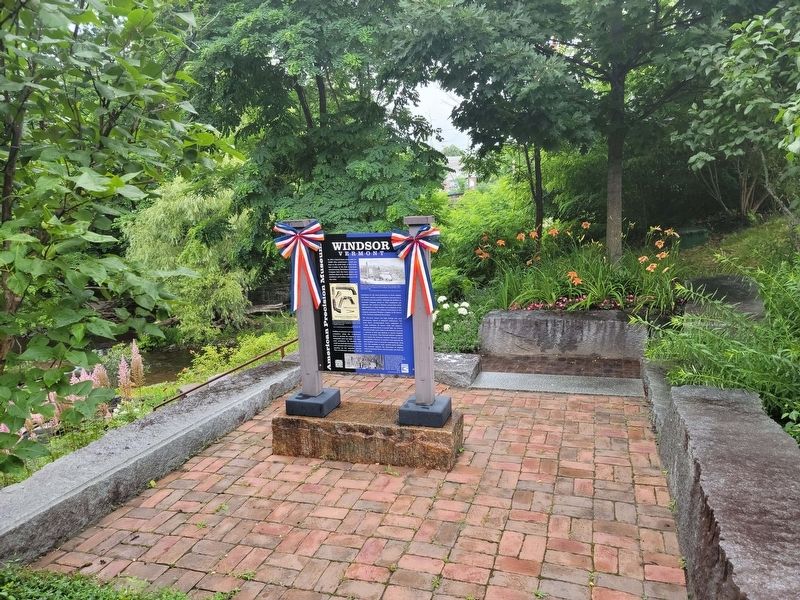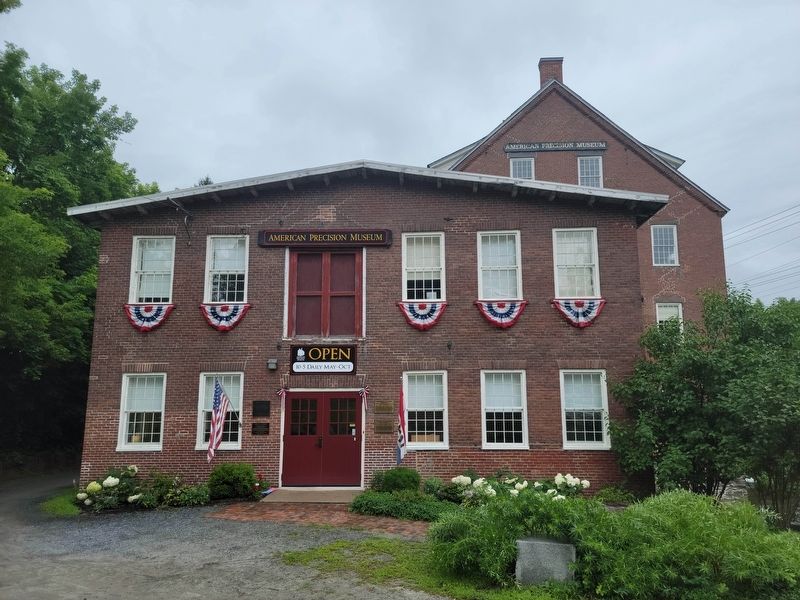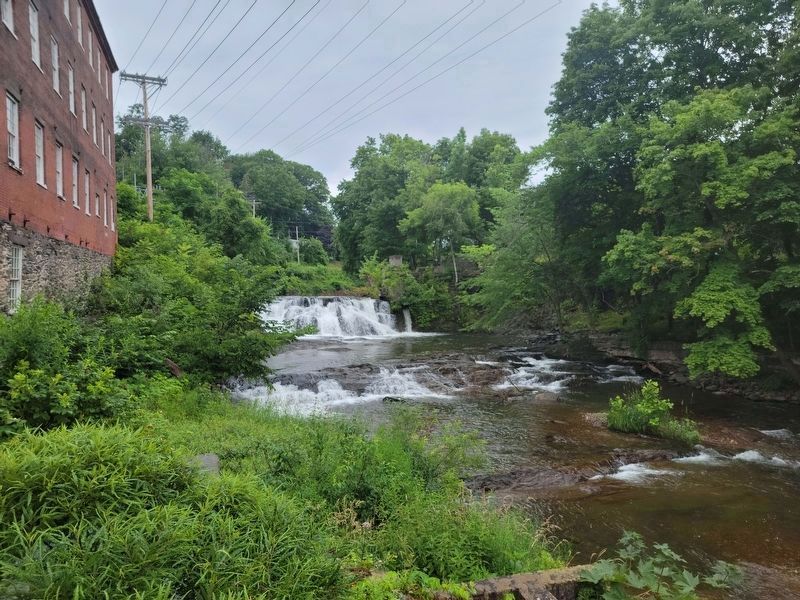Windsor in Windsor County, Vermont — The American Northeast (New England)
American Precision Museum / Mill Brook & Waterpower
Windsor Vermont
American Precision Museum
In 1846 a United States Army order for 10,000 rifles transformed a small gun shop on the north bank of Mill Brook into a leader in the field of precision manufacturing. The Robbins & Lawrence Company built this brick armory and machine shop on the south bank for the machinery and workers required to fill that order.
Robbins & Lawrence was one of several companies along the Connecticut River to develop the concept of interchangeable parts and apply it to large- scale production. Its machine tools could cut wood and metal parts for rifles with accuracy and consistency, thereby speeding up the assembly process. This revolutionary technology laid the foundation for the mass production of items ranging from shoes, watches, sewing machines, and typewriters to bicycles and automobiles. Although the Robbins & Lawrence Company closed in 1856, machinists and engineers who trained in Windsor carried their skills and ingenuity to other machine tool companies in the region and beyond. The technical innovations of this company guaranteed Windsor a chapter in the history of the American Industrial Revolution.
The four-story armory has high ceilings and wood construction typical of industrial architecture. The wood floors accommodated heavy equipment for a large workforce. Its narrow width and expansive windows provided plenty of natural light. An 18-foot, iron and wooden water wheel in the basement powered a network of belts and shafting to operate machine tools in the factory. This National Historic Landmark now houses the American Precision Museum and its unparalleled collection of machine tools spanning the first hundred years of precision manufacturing, along with fine examples of early, machine-made products. The museum explores the importance of machine tools in American history and the people who built and used them.
( photo caption ) In the mid 1850s, Robbins & Lawrence manufactured the revolving-hammer pistol, patented by George Leonard in 1849 for civilian use. Courtesy Terry Tyler (from a broadside designed by Christian Meadows, Windsor, Vt.)
( photo caption ) Robbins & Lawrence added steam power by 1850, evident in the steam engine house and stack in the foreground of this lithograph. (Map of Windsor County, Hosea Doton, 1855) Courtesy Special Collections, Bailey/Howe Library, University of Vermont
( photo caption ) Factories nationwide embraced the technology of interchangeable parts. In this scene at the Weed Sewing Machine Factory in Hartford, Connecticut, workers produce parts for sewing machines. The arrangement of equipment and workers was similar at the Robbins & Lawrence armory. (Scientific American, March 20, 1880) Courtesy American Precision Museum
Mill Brook & Waterpower
In the 1700s Mill Brook was a reliable source of waterpower for small industry in the rural community of Windsor. Its three falls, dropping 60 feet in three- fourths of a mile, powered grist and saw mills that provided settlers with food and lumber for building. Shops producing ironwork, shoes, leather goods, and textiles soon joined these early industries.
By 1846 the Robbins & Lawrence Company had fully developed the waterpower here at the middle falls with an armory on the south bank. The company manufactured rifles and machine tools that produced interchangeable parts for a wide range of products. Machine shops and assembly buildings occupied the north bank into the early 1900s. In 1924 the National Acme Company, an automatic lathe and machine parts manufacturer, built the apartment block on the north bank to house a large labor force.
Windsor resident Frank Kennedy purchased the dams and properties along Mill Brook, including the armory, in 1898 and generated electricity using waterpower and coal-fired steam from 1902 to 1926. His heirs sold the facility to Windsor Electric Company, and in 1929 it became part of Central Vermont Public Service. Electricity generation ceased in the 1930s, but the property continued to be used as a transmission substation. The American Precision Museum purchased the armory in 1965.
( photo caption ) A variety of enterprises clustered around Mill Brook in 1855, including the Robbins & Lawrence armory, a railroad car shop, a pail factory, a foundry, and boarding houses for workers. (Map of Windsor County, Hosea Doton, 1855) Courtesy Special Collections, Bailey/Howe Library, University of Vermont
( photo caption ) The wooden penstock (above left), installed in the early 1870s, fed a water turbine that worked with a steam engine to power the site. (Factory Complex Sales Prospectus, C. 1915) Courtesy Windsor Historical Society
( photo caption ) Water Wheel Isometric Historic View ca. 1846
Water above the dam traveled through the headrace and followed the box flume in the basement to power the 18-foot- diameter breast wheel in the wheel pit before exiting through the tailrace. Courtesy Historic American Engineering Record, National Park Service (delineated by German Osorio, Christopher H. Marston, Pavel Gorokhov, 2009)
Topics. This historical marker is listed in this topic list: Industry & Commerce. A significant historical date for this entry is March 20, 1846.
Location. 43° 28.472′ N, 72° 23.359′ W. Marker is in Windsor, Vermont, in Windsor County. Marker is at the intersection of Main Street (U.S. 5) and Maple Street, on the right when traveling south on Main Street. Located next to the American Precision Museum building. Touch for map. Marker is at or near this postal address: 196 Main Street, Windsor VT 05089, United States of America. Touch for directions.
Other nearby markers. At least 8 other markers are within walking distance of this marker. Robbins and Lawrence Armory and Machine Shop (here, next to this marker); Edwin A. Battison (here, next to this marker); a different marker also named Robbins and Lawrence Armory and Machine Shop (here, next to this marker); International Mechanical Engineering Heritage Collection (here, next to this marker); a different marker also named Robbins and Lawrence Armory and Machine Shop (within shouting distance of this marker); Windsor Veterans Monument (approx. ¼ mile away); Mount Ascutney & Its People / Old South Church (approx. ¼ mile away); Windsor’s First Meeting House (approx. ¼ mile away). Touch for a list and map of all markers in Windsor.
Also see . . .
1. American Precision Museum. (Submitted on August 26, 2021, by Michael Herrick of Southbury, Connecticut.)
2. American Precision Museum (Wikipedia). (Submitted on August 26, 2021, by Michael Herrick of Southbury, Connecticut.)
3. Town of Windsor, Vermont. (Submitted on August 26, 2021, by Michael Herrick of Southbury, Connecticut.)
4. Windsor, Vermont (Wikipedia). (Submitted on August 26, 2021, by Michael Herrick of Southbury, Connecticut.)
Credits. This page was last revised on August 1, 2023. It was originally submitted on August 26, 2021, by Michael Herrick of Southbury, Connecticut. This page has been viewed 233 times since then and 46 times this year. Photos: 1, 2, 3, 4, 5. submitted on August 26, 2021, by Michael Herrick of Southbury, Connecticut.
